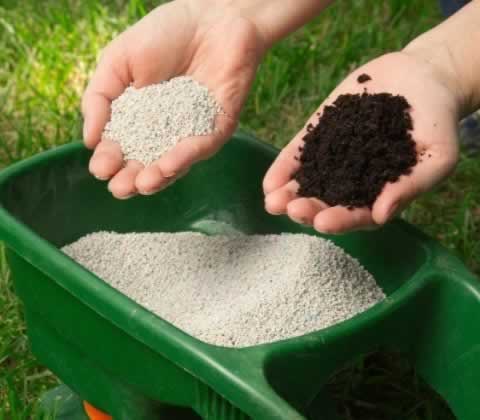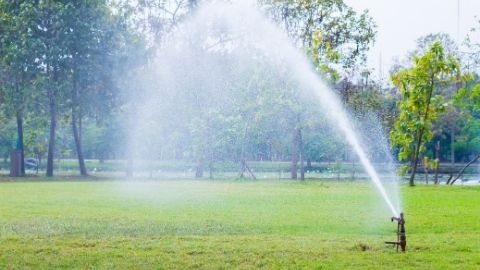What’s the Best Way of Fertilizing Lawn?
Fertilizer provides nutrients that allow the lawn to grow and flourish. It keeps it looking good, maximizes the dark green color and helps it better copy with seasonal turf stresses like heat, drought as well as cold. It contains nitrogen, phosphorus, and potassium nutrients that are vital to the health of your lawn.
A well-fertilized lawn can also choke out weeds with strong roots and prevent them from being established in the first place. However, most lawns are always malnourished and don’t look as good as they should due to reduced fertilizer applications. Patchiness, browning, and weed invasion are signs of a starving or struggling lawn. These problems can be solved by proper fertilizer application and good lawn maintenance.
Fertilize At The Right Time of Year
In order to properly apply your fertilizer and achieve desirable results, you need to consider the right time of the year to do so. Therefore, you should fertilize at the beginning of the growing season. This varies with the different types of grasses. For instance, warm-season grasses may be fertilized at the beginning of spring when the grass begins to turn green. Warm-season grasses flourish in the heat of the summer and should be fed throughout the growing season. During the heat of the summer, cool-season grasses will be in a survival mode. Therefore, you should refrain from applying fertilizer to a lawn in mid- or late summer. Cool-season grasses should need nothing other than water and pest management until September.
A Winterize fertilizer can be used towards the end of the summer to protect the grass over the fall and winter. If you prefer organic fertilizing methods, it is advisable to make a single “turf-builder” application in the early fall to build root systems. You may then omit the use of fertilizer during the spring and summer and rely on the nitrogen from mulched grass clippings to feed your lawn. If you were using traditional fertilizer, apply two to three light applications per growing year. Then once in the spring and one at midsummer in regions where it is necessary and one “turf-builder” application in the early fall. The right time to fertilize lawn depends on your zone and the type of turf grasses you have. Therefore, I recommend that you consult an expert at a local garden center if you don’t have your area and type of lawn knowledge.
Test the soil

Before using fertilizer to change the pH, you must ensure that what you are adding is what your lawn truly needs. Therefore, when your ground isn’t frozen, you can test your soil for its nutrient content, pH, and organic matter composition. To get a good sample, dig a few inches down to where the roots feed and obtain about a pint of soil from four or five different areas of the lawn. A pH soil testing kit may be bought at garden stores to measure the soil’s alkalinity or acidity. You can purchase soil test kits or use an electronic soil tester.
The soil test may be appropriately done by following the instructions on the kit. As a result of this, you would be able to determine what pH your fertilizer should have. For example, if the soil has high acidity or alkalinity, it is advisable to choose a fertilizer that will balance your grass for optimal growth. As a way of obtaining the most comprehensive test results, information about the lawn’s nutrients. Soil samples should be sent into a soil testing lab or a local agriculture extension.
Determine The Fertilizer Type
It is wise to research before selecting the ideal fertilizer at a garden store. There are some factors that you have to keep in mind when deciding to buy fertilizer. Firstly, you can get either granular or liquid fertilizer. Granular fertilizers get absorbed more slowly and get sprinkled across the lawn. Liquid fertilizers are absorbed quickly; hence they need to be reapplied every few weeks. Secondly, you can choose between slow release and quick release of granular fertilizers. Slow-release granular fertilizers need to be applied only once or twice in a growing season. Thirdly, you can choose between chemical or organic fertilizer. It is advisable for you to use an organic fertilizer as it doesn’t only kill weeds but preserves your lawn’s health in the long term.
Factors to consider when choosing fertilizer
1)Know your grass

When choosing the type of fertilizer, you must know the kind of grass growing in your yard. The type of grass may determine which type of fertilizer you need to use as well as how often you need to fertilize. For example, regions differ, some have warm-season grasses primarily, and others have cool-season lawns primarily. Warm-season grasses turn brown in the fall after the first frost of the year. Their examples include Augustine, Bahia, Carpet grass, and many more. Then cold season grasses fade to a light tan or brown color during the coldest winter days in most climates. Examples include Fine Fescue, Bluegrass, bentgrass, and ryegrass. Therefore, you should consult your neighbors who have similar grass if they don’t know what type of grass is growing in their yard. If you do not have neighbors who have identical grass, simply take a sample to your local garden center.
2)Measure your lawn.
To buy the right amount of fertilizer, you have to know the square footage. To find out the square footage, multiply the length of the yard by its width. In the process, ensure that areas that won’t need to be fertilized, like landscaped areas and your home, are subtracted.
3)Select The Type of Fertilizer That is Easy to Apply
When you’re spraying fertilizer, it is difficult for a homeowner to get a consistent and even application across the lawn. However, when professional landscapers apply fertilizer, they have the proper equipment that allows them to know how to factor in for the wind as well as making sure the yard gets even coverage. Therefore, homeowners should use granules that are simple to apply accurately using a spreader.
4)Measure out Fertilizer
For you to determine how much fertilizer is needed to maintain your lawn, you have to know the surface area. First of all, determine the total area of your property. Second, subtract the areas not to be fertilized. To learn how much fertilizer is needed, the remaining square footage is the number needed.
Fertilizing Your Lawn
1)Prepare The Spreader
If you want to ensure that the spreader works appropriately, open and close your spreader while it is empty, check the packaging to see the recommended amount, how often the fertilizer should be applied, as well as under what conditions it should get used. Do not fill the applicator while the spreader is parked on the grass as this might get grass burnt. It is possible to discharge too much while loading accidentally.
Therefore, it is advisable to fill the applicator somewhere else, then wheel the spreader to the grass area. When filling the spreader, you should ensure that it is filled with the appropriate fertilizer that suits your lawn’s needs. Then adjust the spreader to ensure that the release of fertilizer matches the recommended dosage on the fertilizer bag.
2)Start Fertilizing.
Before fertilizing the check, the weather forecast as applying fertilizer right before a downpour would result in much of the fertilizer get washed away. Start by using fertilizer around the perimeter of the yard, then fill in the middle, working in one direction while walking at a reasonable pace. Once you have done this, spread it again, moving in a perpendicular direction. It is through this crisscrossing pattern that you will cover much better coverage and prevent over-applying the fertilizer.
You should ensure that you remain as constant as possible without stopping, slowing, or speeding your pace or turning off the spreader. Failing follows that will result in the fertilizer being spread too thin in some spots. And also too thick in others. When covering the entire yard with the fertilizer, make sure that you do not overlap or skip areas and spread too much fertilizer. If you are not careful about the amount of fertilizer that is covered, your yard could experience chemical burn. Once you’ve completed, clean your spreader and spray the inside and the outside with a water hose. If there is any leftover fertilizer, simply pour it out of the spreader and back into its original bag. Then tightly seal the bag and store it away from children in a cool, dry place.
Water Your Lawn After Fertilizing

After you have finished fertilizing your lawn, water it so that the soil absorbs the fertilizer, you should fertilize your lawn for about six weeks if you have an automatic sprinkler system. Also you can wait for an additional two weeks between feedings if you do not have a sprinkler system. Always carefully read the fertilizer label to know whether you should water the lawn before or after applying the fertilizer. For instance, some fertilizers require you to soak the lawn before application, and granulated fertilizers need moisture to break down.
Necessity of Fertilizer Spreader in Successfully Fertilizing
It is vital to choose proper equipment that can have a positive impact on the results of their lawn fertilization. Homeowners can use a broadcast spreader as it is more comfortable to use and pretty much affordable as they start from $30.This type of spreader disperses fertilizer over a more extensive distance. As a result, there is less chance you are likely to end up with stripes in your yard caused by not correctly overlapping the rows. When fertilizing small yards, a handheld broadcast spreader with a hand crank may be used.
This type of broadcast spreader can be bought for as little as $15. Handheld broadcast spreaders are ideal for precise fertilizing areas like the narrow side yards, grassy areas along the fence lines, around trees, flower beds, and landscapes. For a large lawn, it is advisable to buy or rent equipment like a rotary spreader to spread fertilizer throughout your yard evenly. Irrespective of what type of spreader you use, always ensure that you walk at a consistent, steady pace as you apply the fertilizer.
Effects of Too Much Fertilizing
Correctly applying the fertilizer is extremely important when growing a healthy lawn. Using excessive amounts of fertilizer to lawns will cause the nitrogen and salt levels in the soil to increase and damage the grass. Fertilizer burns usually seen through yellow to brown strips or patches of dead grass. Symptoms of this phenomenon appear the day after an application. The problem could best solve by leaching the excess fertilizer out of the ground and reseeding dead patches.
To leach the excess fertilizer, attach a sprinkler head to a garden hose and position the sprinkler over the portion of the overfertilized lawn. Thoroughly saturate the below grass by turning on the sprinkler and allow it to run. Afterward, it will enable the water to drain down through the soil, carrying the excess fertilizer. Further, apply an inch of water per day for the next seven days. Additionally, water the lawn in the morning hours to allow the grass blades to dry to prevent fungal diseases from developing. Then wait three to four days after the last water application to allow the soil time to dry.
Once it has dried, rake up the dead grass blades in the fertilizer-burned areas. Afterward, you can remove the top 2 to 3 inches of soil in the cleared area with a shovel. Get rid of the dead grass and dirt in a wheelbarrow and discard it.
Fertilizing at The Wrong Time
Fertilizer applied during drought is more likely to burn a lawn than to help it grow. Water and fertilizer are both necessary for photosynthesis. Thus, without rain, fertilizer won’t work correctly. Hence, before fertilizing your lawn, it is ideal for you to check the weather and only feed before the forecast calls for steady light rain.
You should also avoid fertilizing if the forecast calls for a strong thunderstorm as your fertilizer is likely to run off into your local storm drains and streams before it can be absorbed. It is advisable to fertilize when no rainfall is expected for two days or simply spread the fertilizer before it rains if you’re anticipating only light rain. However, the light rain can substitute for watering the fertilizer after application.
Final Thought
Properly fertilizing the lawn allows the grass to grow and flourish healthily. Before fertilizing the lawn, it is of paramount importance to choose proper equipment that will assist you. When selecting the type of fertilizer, you should know your grass and further measure your lawn. It is also ideal for you to consider a fertilizer that is easier to apply and that of the carters for your lawn’s needs. You should avoid High-Nitrogen fertilizers as they are costly and a health hazard to your lawn.
Before fertilizing your lawn, you should consider the right time of the year to do so. When determining the fertilizer type, it is wise for you to research before selecting the ideal fertilizer. To learn how much fertilizer your lawn needs, you should measure its surface area. Before using fertilizer to change the pH, you must test the soil. Last but not least, correctly applying the fertilizer is extremely important when growing a healthy lawn.
